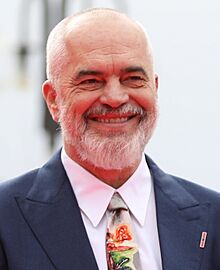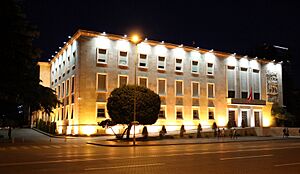Prime Minister of Albania facts for kids
Quick facts for kids Prime Minister of Albania |
|
|---|---|
 |
|
| Style | His Excellency (diplomatic) |
| Member of |
|
| Residence | Kryeministria |
| Seat | Tirana |
| Appointer | President
with Parliament confidence
|
| Term length | Four years,
renewable
|
| Constituting instrument | Constitution |
| Inaugural holder | Ismail Qemali |
| Formation | 4 December 1912 |
| Deputy | Deputy Prime Minister |
| Salary | L228,730 |
The Prime Minister of Albania (Albanian: Kryeministri i Shqipërisë) is the main leader of the government in Albania. This important job was created after Albania became independent on November 28, 1912. Since then, Albania has gone through many changes, from being a kingdom to a communist country, and finally, a democracy.
In 1912, Ismail Qemali became Albania's first Prime Minister, helping the country become its own nation. Later, in 1944, Enver Hoxha led a government that controlled everything and kept Albania separate from other countries. In 1991, Albania became a democracy, and Fatos Nano was the first Prime Minister after this big change.
The role of the Prime Minister is set out in Albania's constitution. First, there are general elections where people vote for members of the parliament. The leader of the party that wins the most seats in parliament usually becomes the Prime Minister. The President then asks this leader to suggest someone for the job. The parliament must agree to this choice.
Once chosen, the Prime Minister takes an oath in front of the President. The Prime Minister is in charge of forming and leading the Council of Ministers (like a cabinet). They also create the country's main policies and make sure government groups work together. The Prime Minister's official office is called the Kryeministria, located in Tirana. Since September 2013, Edi Rama from the Albanian Socialist Party has been the Prime Minister.
Contents
History of Albania's Prime Ministers
Early Years (1912–1990)
After Albania declared independence in 1912, the job of Prime Minister became a key part of the country's government. Many leaders took on this role during a time of big changes and conflicts.
Ismail Qemali was the very first Prime Minister, guiding Albania to become an independent nation. Later, during World War I, leaders like Turhan Përmeti and Esad Toptani worked hard to keep Albania independent. In 1920, Ilias Vrioni helped solve border issues after the war.
Ahmet Zogu became Prime Minister in 1922. He focused on making the government stronger and improving the economy. In 1924, Fan Noli briefly served as Prime Minister and introduced reforms in education and land. Zogu returned as Prime Minister in 1925 and later became the king in 1928.
During the Great Depression (1930-1939), Prime Ministers like Kostaq Kotta, Pandeli Evangjeli, and Mehdi Frashëri worked to fix Albania's economic problems. During World War II, Albania was invaded by Italy and then Germany. Prime Ministers such as Shefqet Vërlaci, Mustafa Merlika-Kruja, Rexhep Mitrovica, Fiqri Dine, and Ibrahim Biçakçiu led the country during these difficult times.
After World War II, Enver Hoxha became Prime Minister in 1944. He led Albania as a communist country, focusing on making it more modern and industrial. Mehmet Shehu was another important Prime Minister during this period, serving for many years. Adil Çarçani followed him, keeping Albania isolated from many other countries.
Modern Era (1991–Present)
After communism ended in Albania, the role of Prime Minister was brought back, and the country became a democracy. In 1991, Fatos Nano became the first Prime Minister of the new democratic Albania. He worked to build democratic groups and improve the economy.
After Nano, Ylli Bufi and Vilson Ahmeti served briefly. Then, Aleksandër Meksi became Prime Minister in 1992. His government worked to strengthen democracy and Albania's ties with other countries. However, his time in office faced challenges, including the 1997 Albanian civil unrest.
Bashkim Fino became Prime Minister in 1997, followed by Fatos Nano again. Pandeli Majko took over in 1998, focusing on keeping public order and fighting crime. His government also helped approve a new constitution. Ilir Meta then served as Prime Minister until 2002, followed by Majko and Nano again.
In 2005, Sali Berisha became Prime Minister. He worked to grow the economy and help Albania join the European Union (EU) and North Atlantic Treaty Organization (NATO). Albania joined NATO in 2009 during his time. Since 2013, Edi Rama has been the Prime Minister, working on economic growth and reforms to help Albania move closer to joining the EU.
How the Prime Minister is Chosen

The process of choosing Albania's Prime Minister starts with general elections. In these elections, people vote for members of the parliament. The political party or group that wins the most seats in parliament usually has its leader become the main candidate for Prime Minister.
Once the election results are official, the President asks the leader of the winning party to suggest a candidate for Prime Minister. This person then needs to be approved by a majority vote from the members of parliament. If the parliament does not approve the chosen candidate, the President has 10 days to suggest a new one. If that person is also not approved, the parliament gets another 10 days to choose someone else. If no one can be elected, the President can decide to dissolve (close) the parliament.
Before starting their job, the new Prime Minister must take an oath. This ceremony is led by the President. In the oath, the Prime Minister promises to follow the country's constitution and laws, protect the rights of citizens, and work for the good of the Albanian people.
Albanian: Betohem se do t'i bindem Kushtetutës dhe ligjeve të vendit, do të respektoj të drejtat dhe liritë e shtetasve, do të mbroj pavarësinë e Republikës së Shqipërisë dhe do t'i shërbej interesit të përgjithshëm dhe përparimit të popullit Shqiptar. Zoti më ndihmoftë!
English: I swear that I will obey to the Constitution and laws of the country, that I will respect the rights and freedoms of citizens, protect the independence of the Republic of Albania, and I will serve the general interest and the progress of the Albanian people. May God help me!
What the Prime Minister Does
The Kryeministria in Tirana is the official workplace for the Prime Minister. It's a very important place for the Prime Minister and the Council of Ministers to do their jobs.
According to the constitution, the Prime Minister is the head of government. One of their main jobs is to choose and lead the Council of Ministers. This group includes the Deputy Prime Minister and other ministers who lead different parts of the government. The Prime Minister suggests these ministers to the President for approval.
The Prime Minister is also responsible for creating and sharing the country's main policies. They make sure that the laws passed by the Council of Ministers are put into action. On top of this, the Prime Minister helps coordinate and oversee the work of the Council and other government groups. This helps make sure the government runs smoothly and solves any problems between ministers.
The Prime Minister can ask the parliament for a "vote of confidence" on important decisions. This means they want to see if the parliament still supports their government. If the parliament votes no, the Prime Minister might ask for the parliament to be dissolved. If the Prime Minister is away or unable to work, the Deputy Prime Minister takes over to keep the government running.
List of Prime Ministers
| No. | Portrait | Name | Term | Party | Government | Ref. | |||
|---|---|---|---|---|---|---|---|---|---|
| Start | End | Duration | |||||||
| 1 |  |
Ismail Qemali (1844 – 1919) |
4 December 1912 |
22 January 1914 |
1 year, 1 month and 26 days | Independent | Provisional | ||
| – |  |
International Control Commission | 22 January 1914 |
14 March 1914 |
1 month and 24 days | Members | |||
| 2 |  |
Turhan Përmeti (1846 – 1927) |
14 March 1914 |
3 September 1914 |
5 months and 18 days | Independent | Përmeti (I and II) |
||
| 3 |  |
Essad Toptani (1863 – 1920) |
5 October 1914 |
27 January 1916 |
1 year, 3 months and 23 days | Toptani | |||
| – |  |
Turhan Përmeti (1846 – 1927) |
25 December 1918 |
29 January 1920 |
1 year, 1 month and 5 days | Përmeti III | |||
| 4 |  |
Sulejman Delvina (1884 – 1933) |
30 January 1920 |
14 November 1920 |
9 months and 16 days | Delvinal | |||
| 5 |  |
Ilias Vrioni (1882 – 1932) |
15 November 1920 |
16 October 1921 |
11 months and 2 days | Vrioni (I and II) |
|||
| 6 |  |
Pandeli Evangjeli (1859 – 1949) |
16 October 1921 |
6 December 1921 |
1 month and 21 days | Evangjeli | |||
| 7 |  |
Qazim Koculi (1887 – 1943) |
6 December 1921 |
6 December 1921 |
1 day | Koculi | |||
| 8 |  |
Hasan Prishtina (1873 – 1933) |
7 December 1921 |
12 December 1921 |
6 days | Prishtina | |||
| 9 |  |
Idhomen Kosturi (1873 – 1943) |
12 December 1921 |
24 December 1921 |
13 days | Kosturi | |||
| 10 |  |
Xhafer Ypi (1880 – 1940) |
24 December 1921 |
2 December 1922 |
11 months and 9 days | Popular | Ypi | ||
| 11 |  |
Ahmet Zogu (1895 – 1961) |
2 December 1922 |
25 February 1924 |
1 year, 2 months and 24 days | Conservative | Zogu | ||
| 12 |  |
Shefqet Vërlaci (1877 – 1946) |
3 March 1924 |
27 May 1924 |
2 months and 25 days | Progressive | Vërlaci | ||
| – |  |
Ilias Vrioni (1882 – 1932) |
31 May 1924 |
10 June 1924 |
11 days | Independent | Vrioni III | ||
| 13 |  |
Fan Noli (1882 – 1965) |
16 June 1924 |
24 December 1924 |
6 months and 9 days | Liberal | Noli | ||
| – |  |
Ahmet Zogu (1895 – 1961) |
6 January 1925 |
31 January 1925 |
8 months and 18 days | Conservative | Zogu II | ||
| 14 |  |
Kostaq Kotta (1886 – 1947) |
5 September 1928 |
5 March 1930 |
1 year, 6 months and 1 day | Independent | Kotta | ||
| – |  |
Pandeli Evangjeli (1859 – 1949) |
6 March 1930 |
16 October 1935 |
5 years, 7 months and 11 days | Evangjeli (II, III and IV) |
|||
| 15 |  |
Mehdi Frashëri (1872 – 1963) |
21 October 1935 |
7 November 1936 |
1 year and 18 days | Frashëri | |||
| – |  |
Kostaq Kotta (1886 – 1947) |
9 November 1936 |
7 April 1939 |
2 years, 4 months and 30 days | Kotta II | |||
| – |  |
Shefqet Vërlaci (1877 – 1946) |
12 April 1939 |
3 December 1941 |
2 years, 7 months and 22 days | Fascist | Vërlaci II | ||
| 16 |  |
Mustafa Merlika-Kruja (1887 – 1958) |
4 December 1941 |
4 January 1943 |
1 year, 1 month and 1 day | Merlika-Kruja | |||
| 17 |  |
Ekrem Libohova (1882 – 1948) |
18 January 1943 |
11 February 1943 |
25 days | Libohova | |||
| 18 |  |
Maliq Bushati (1890 – 1946) |
12 February 1943 |
28 April 1943 |
2 months and 17 days | Bushati | |||
| – |  |
Ekrem Libohova (1882 – 1948) |
11 May 1943 |
10 September 1943 |
4 months | Libohova II | |||
| 19 |  |
Rexhep Mitrovica (1887 – 1967) |
5 November 1943 |
16 June 1944 |
7 months and 12 days | National Front | Mitrovica | ||
| 20 |  |
Fiqri Dine (1897 – 1960) |
18 July 1944 |
28 August 1944 |
1 month and 11 days | Dine | |||
| 21 |  |
Ibrahim Biçakçiu (1905 – 1977) |
6 September 1944 |
25 October 1944 |
1 month and 20 days | Biçaku | |||
| 22 |  |
Enver Hoxha (1908 – 1985) |
10 November 1944 |
20 July 1954 |
9 years, 8 months and 10 days | Labour | Hoxha (I, II and III) |
||
| 23 |  |
Mehmet Shehu (1913 – 1981) |
20 July 1954 |
18 December 1981 |
27 years, 4 months and 29 days | Shehu (I, II, III, IV, V, VI and VII) |
|||
| 24 | Adil Çarçani (1922 – 1997) |
4 January 1982 |
22 February 1991 |
9 years, 2 months and 4 days | Çarçani (I, II and III) |
||||
| 25 |  |
Fatos Nano (born 1952) |
22 February 1991 |
4 June 1991 |
3 months and 14 days | Socialist | Nano (I and II) |
||
| 26 | Ylli Bufi (born 1948) |
5 June 1991 |
10 December 1991 |
6 months and 6 days | Stability | ||||
| 27 | Vilson Ahmeti (born 1951) |
10 December 1991 |
4 April 1992 |
3 months and 26 days | Ahmeti | ||||
| 28 |  |
Aleksandër Meksi (born 1939) |
13 April 1992 |
25 March 1997 |
4 years, 11 months and 13 days | Democrat | Meksi (I and II) |
||
| 29 | Bashkim Fino (1962 – 2021) |
13 March 1997 |
25 July 1997 |
4 months and 13 days | Socialist | Fino | |||
| – |  |
Fatos Nano (born 1952) |
25 July 1997 |
28 September 1998 |
1 year, 2 months and 4 days | Nano III | |||
| 30 |  |
Pandeli Majko (born 1967) |
28 September 1998 |
29 October 1999 |
1 year, 1 month and 2 days | Majko | |||
| 31 |  |
Ilir Meta (born 1969) |
29 October 1999 |
29 January 2002 |
2 years, 3 months and 1 day | Meta (I and II) |
|||
| – |  |
Pandeli Majko (born 1967) |
7 February 2002 |
24 July 2002 |
5 months and 18 days | Majko II | |||
| – |  |
Fatos Nano (born 1952) |
24 July 2002 |
8 September 2005 |
3 years, 1 month and 16 days | Nano IV | |||
| 32 |  |
Sali Berisha (born 1944) |
8 September 2005 |
11 September 2013 |
8 years and 4 days | Democrat | Berisha (I and II) |
||
| 33 |  |
Edi Rama (born 1964) |
11 September 2013 |
Incumbent | 11 years, 11 months and 27 days | Socialist | Rama (I, II and III) |
||
Timeline of Prime Ministers

See also
 In Spanish: Primer ministro de Albania para niños
In Spanish: Primer ministro de Albania para niños



